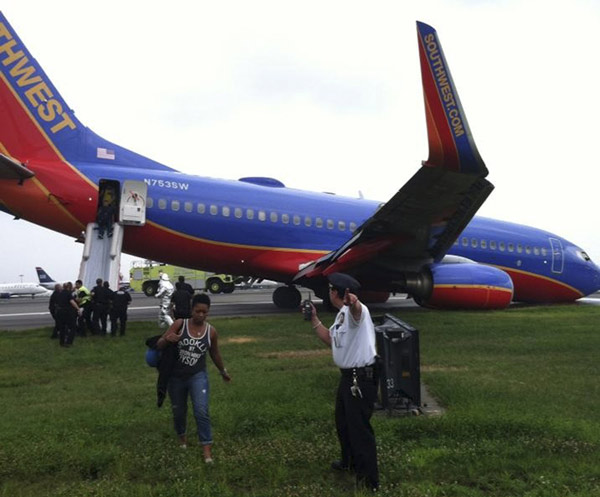Capt took control 120m above ground in accident
Updated: 2013-08-07 07:58
(Agencies)
|
|||||||||||
NEW YORK - The captain of a Southwest Airlines plane that landed on a collapsing nose gear at LaGuardia Airport took control from the first officer just 400 feet (120 meters) from the ground, the National Transportation Safety Board said Tuesday.
 |
|
A Southwest Airlines plane sits on the tarmac as passengers disembark at LaGuardia airport in New York, July 22, 2013, in this photo courtesy of @mattjfriedman and Frank Ferramosca. [Photo/Agencies] |
It's unusual for a co-pilot or captain to take over a plane that's landing when it's so close to the tarmac unless there are "profound" safety issues, a private aviation expert said.
Sixteen people were injured in the July 22 hard landing, which the NTSB is still investigating.
The federal aviation agency on Tuesday issued an update report that offers a glimpse into what happened in the cockpit of the Boeing 737 minutes before its nose hit the tarmac and the landing gear collapsed, sending it skidding before it came to a halt in a grassy area.
Passengers quickly exited the plane using emergency chutes. Of the 16 injured passengers, at least six were hospitalized.
The NTSB said Tuesday that as the plane approached LaGuardia the captain had been monitoring the landing and suddenly took over from the first officer. NTSB officials said the latest information was only "a factual update" and they could not answer further questions as the probe continues.
Private aviation consultant Peter Goelz, a former NTSB managing director, said it's clear the NTSB is focusing on the first officer's performance. He said it's unusual for a captain to take over the command of a landing aircraft in the final moments "unless he is asked to by the co-pilot _ or unless the captain perceives there is a problem and that he must intervene because of profound safety concerns."
Air Line Pilots Association accident investigator John Cox, a former US Airways pilot, agreed it's rare to have a change in the flying pilot at 400 feet (120 meters), occurring perhaps "a few times" in a pilot's career. But Cox, president of Safety Operating Systems, a Washington-based aviation consulting firm, said the reason doesn't necessarily rest with the co-pilot or, in this case, the first officer, who Cox said is clearly experienced.
The NTSB said the captain has been at Dallas-based Southwest Airlines Inc. for more than a dozen years, with more than 12,000 total flight hours including 8,000 on Boeing 737s.
The first officer has been with the airline for about a year and a half, flying 5,200 hours including 4,000 as pilot-in-command. He's logged about 1,100 hours in 737s, none of them as pilot-in-command.
The first officer had "previous operational experience" at LaGuardia, including six flights this year, the NTSB said. And the captain reported having flown into LaGuardia twice, including the accident flight, serving as the pilot monitoring for both flights.
Related Stories
Asiana crash victims' ashes returned to relatives 2013-07-29 13:41
Plane's front gear collapses in LaGuardia landing 2013-07-23 09:20
Air crash victim killed by fire truck 2013-07-21 08:21
Vehicle kills one Asiana air crash victim: coroner 2013-07-20 03:48
Asiana legal fallout begins after deadly crash 2013-07-20 00:26
Air crash payouts could differ 2013-07-16 07:28
Today's Top News
Two more companies recall milk products
Small firms should also think global
NBA courts Sina Corp
Govt to court private capital
EC denies delay in telecoms probes
Snowden obtains formal registration
Japan's new warship draws fire
Commission sets no timetable for family planning update
Hot Topics
Lunar probe , China growth forecasts, Emission rules get tougher, China seen through 'colored lens', International board,
Editor's Picks

|

|

|

|

|

|





